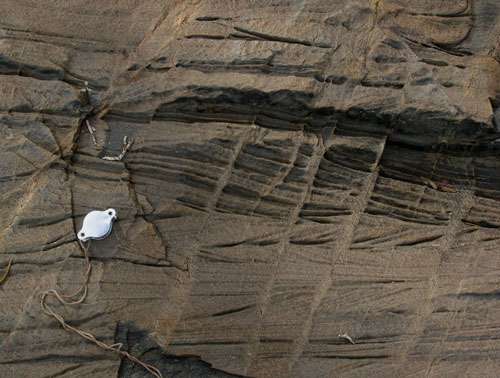It may not look particularly cosmic, but the rock below not only tells us that the Moon was present back in the Archean, but also that it was orbiting the Earth at a much closer distance than it is today.

It’s a shame I neglected to take a picture of the whole outcrop – a wide expanse of grey sandstone covered by hundreds of sets of cross-beds (laminations inclined at an angle to the bedding surfaces) like those in the close-up shot above. As I briefly discussed in yesterday’s post, the sandstone itself tells an interesting story about the emergence of the one of the first continental landmasses (or, at least, the earliest we know about) above sea level 3.2 billion years ago. But it is the information preserved in the cross-beds which provides the clues about the status of our nearest extraterrestrial neighbour. Cross-beds are formed by migrating bedforms, such as dunes and ripples. They migrate because the flow of water (or, sometimes, air) is constantly pushing sediments particles over the crest of the bedform onto its lee side, where it collects. The cross laminations are due to changes in current strength, which increase or reduce the maximum size of particle which can be carried over the top; a weaker current will lead to the deposition of finer particles, a stronger one results in coarser particles.

Below I’ve highlighted one set of cross-beds, which records flow from left to right across the image. Note also how an overlying sand lens has cut down into the cross-beds, causing them to be truncated at the erosional boundary. From this way we know which way is up – often an important thing to be able to work out in highly deformed areas like Barberton.

So, how do we know these cross-beds are formed by tidal currents? There are a couple of clues, one fairly obvious, one a bit more subtle. The first is found in the two cross-bedded layers immediately beneath the one we’ve been looking at, which are oriented in opposite directions to each other and hence record antiparallel current directions. This ‘herringbone cross-stratification’ (also known in some circles as ‘chevron cross-stratification’) is fairly diagnostic of a tide-dominated environment, since rivers don’t tend to suddenly flow upstream.

However, don’t go thinking that these two beds represent one tide-in-tide-out cycle. Because one tidal current is often much stronger than the other (due to things like shoreline geometry), and tends to dominate the form of any sedimentary structures, each set is the product of many tidal cycles. There is in fact evidence that this is the case, evidence which also confirms a probable tidal influence. A tidal environment is one with highly variable current strength as well as direction, with periods at low and high tide where it is very low indeed. At these points, only very fine mud particles will be deposited on the sea bottom, forming ‘mud drapes’ interleaved between the sandy cross-beds. These muddy layers are clearly present in the Moodies cross-beds: they’re the horizons which are preferentially being weathered out to produce a light/dark stripy texture.

So, this outcrop represents pretty strong evidence of a lunar influence on sedimentary processes back in Archean times. But there’s more. As well as the twice-daily (diurnal) cycle of high and low tides, there is also the monthly spring-neap cycle. Currents tend to be much stronger during the high spring times, and weaker during the low neap tides, and this long-term variation can also be expressed by changes in bed thickness and grain size in the cross-bedded horizon. I wasn’t actually looking for it when taking the photo I’ve been using here, and I wouldn’t bet the farm on it, but there does seem to be a variation of that sort in the first horizon I highlighted.

What’s cool about this is that if you’re very careful, you can use the number of cross-beds within each of these cycles to estimate the length of the lunar month. Analysis of the Moodies Group [1] suggests that an Archean month – and hence the orbital period of the Moon around the Earth – was only 20 days long. Factoring in the fact that the Earth’s day would also have been much shorter (it is lengthening over time due to the effects of tidal friction, appropriately enough), you have to conclude that the Moon had a much tighter orbit.
This is why I love geology: they may be drab, these cross-beds, but look at them in the right way and you are rewarded with a much more dramatic picture, of Luna looming very large in the Archean night.
Categories: Archean, geology, paper reviews, past worlds



Comments (7)